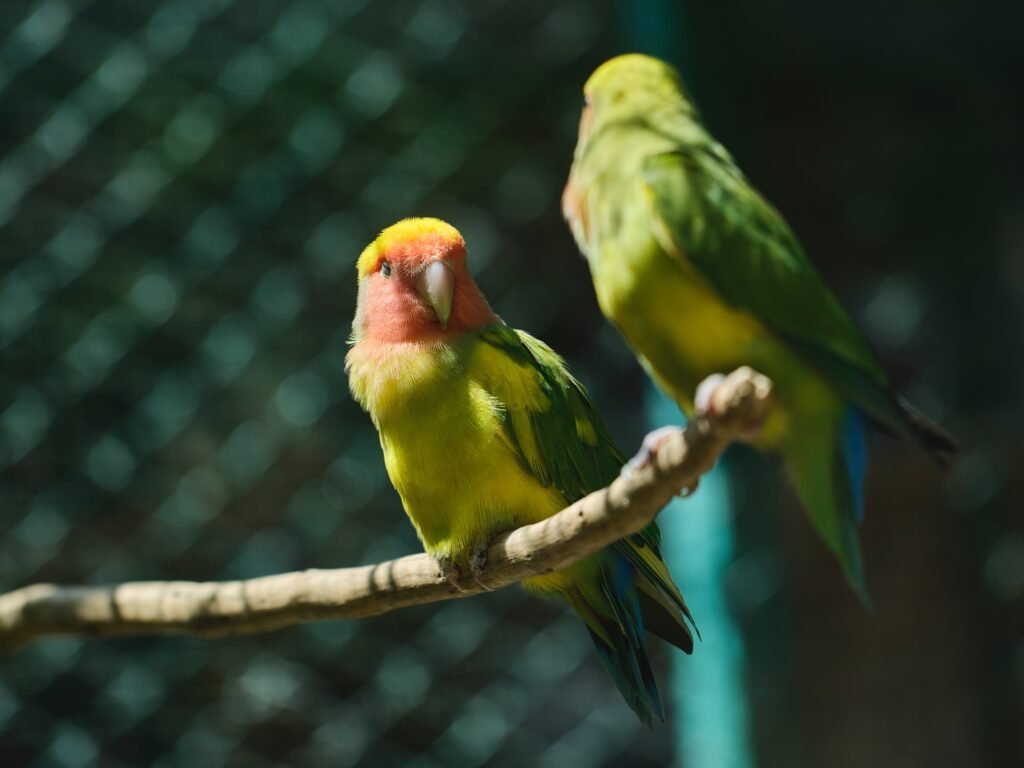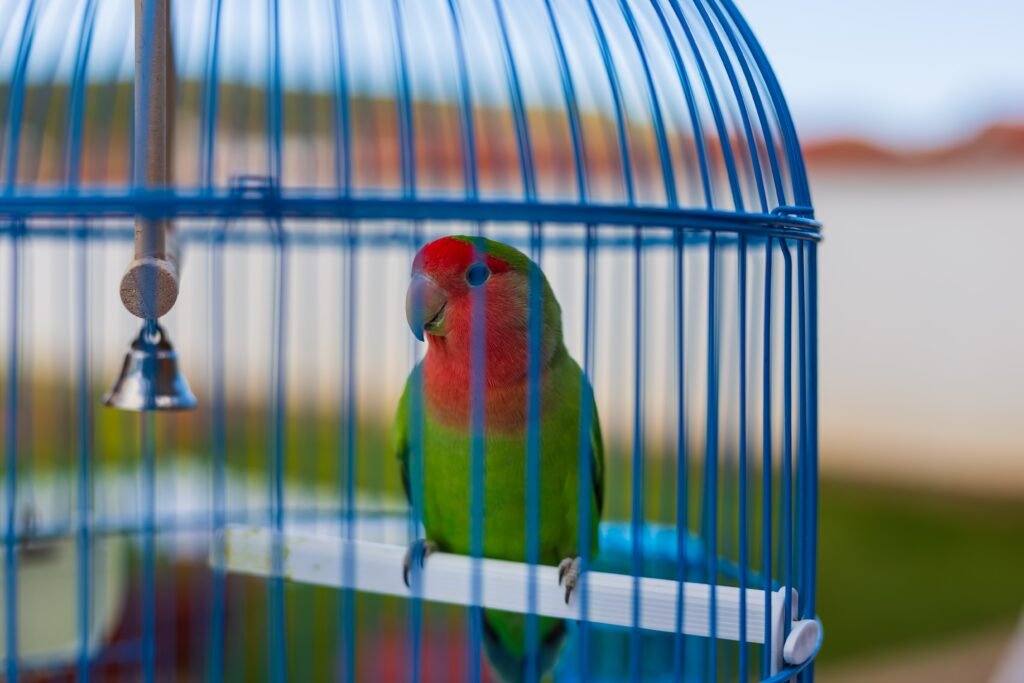Creating a suitable environment for your lovebirds is crucial to their well-being and happiness. Lovebirds are small, enchanting birds that thrive in a well-maintained habitat. You can ensure that they lead a healthy and fulfilling life by providing them with a comfortable and stimulating living space. This article will discuss some essential elements and tips to help you create the perfect environment for your beloved lovebirds.
Cage Selection and Placement
Choosing the right cage for your lovebirds is the first step towards creating their ideal living space. Opt for a spacious cage for them to move around comfortably, stretch their wings, and engage in various activities. A good guideline is to select a cage at least 24 inches in width, 18 inches in depth, and 24 inches in height for a pair of lovebirds.
To provide a safe and secure environment, ensure the cage is made of durable materials with bar spacing that prevents the birds from escaping or getting stuck. It is important to avoid cages with toxic paints or coatings that could be harmful to your pets. Additionally, consider a cage with a removable tray at the bottom for easy cleaning, as maintaining cleanliness is crucial for the health of your lovebirds.
Place the cage in a well-lit area, away from direct sunlight, drafts, and excessive noise. Lovebirds are social birds, so it is best to position the cage in a room where they can interact with the family and have some quiet time. This will provide them with a sense of security and comfort.
Perches, Toys, and Stimulation
Lovebirds are active and playful creatures, so providing them with various perches and toys is essential to keep them mentally and physically stimulated. Place multiple perches of different diameters inside the cage to promote foot exercise and prevent problems. Natural wooden perches are recommended as they provide a more authentic feel and allow your lovebirds to gnaw on them if desired.
Toys play a significant role in keeping lovebirds entertained and preventing boredom. Offer a mix of toys, such as swings, bells, ladders, and puzzle toys, to cater to their instincts and provide them with opportunities for exploration and play. Rotate the toys regularly to maintain their interest and introduce new ones periodically to keep their environment fresh and exciting. Ensure the toys are made of bird-safe materials and free from small parts that could be ingested, as safety should always be a top priority.
In addition to perches and toys, it is important to provide mental stimulation for your lovebirds. Consider placing a mirror in the cage, as lovebirds enjoy looking at their reflections and interacting with them. You can also provide them with foraging toys or puzzle feeders to encourage problem-solving and mimic their natural foraging behavior in the wild. You are promoting their overall well-being and happiness by engaging their minds and bodies.
Bedding and Cage Maintenance
A clean and hygienic living space is vital for the health of your lovebirds. Line the cage bottom with suitable bedding material, such as paper or corn cob bedding, to absorb droppings and minimize odor. Avoid using cedar or pine bedding, as they can release harmful fumes that can be hazardous to your birds’ respiratory system.
Regularly clean the cage by removing uneaten food, droppings, and soiled bedding. This will help prevent the buildup of bacteria and parasites that can lead to health issues. Daily, provide fresh food and water, ensuring they are placed in easily accessible cage areas. It is important to disinfect the cage and accessories using bird-safe cleaning products regularly, as this will help maintain a clean and healthy environment for your lovebirds.
Temperature and Humidity Control
Maintaining the right temperature and humidity levels in your lovebirds’ environment is essential for their well-being. Lovebirds are native to tropical regions and prefer temperatures between 70 to 80 degrees Fahrenheit. It is important to avoid placing the cage near air conditioning or heating vents, as sudden temperature fluctuations can stress the birds and compromise their health.
You can use a humidifier or place a shallow water dish near the cage to regulate humidity. This will help create a more comfortable environment for your lovebirds, as they enjoy a slightly higher humidity. However, it is important to change the water regularly to prevent bacterial growth and ensure the water remains clean and fresh. Monitoring the humidity levels with a hygrometer is recommended to keep it within the optimal range of 40 to 60 percent.
Diet and Nutrition
A balanced and nutritious diet is crucial for the overall health of your lovebirds. Their diet should include fresh fruits, vegetables, high-quality commercially available bird food, and occasional treats like millet sprays. It is important to avoid feeding them avocados, chocolate, caffeine, alcohol, and any foods toxic to birds, as these can harm their health.
Fresh water should be available at all times, and the water container should be cleaned daily to prevent the growth of harmful bacteria. Lovebirds also enjoy bathing, so providing them with a shallow dish of water for bathing purposes will help keep their feathers clean and healthy. This will also provide them enrichment and a way to cool down during warmer days.
Social Interaction and Enrichment
Lovebirds are highly social birds that thrive on companionship and interaction. If you have a single lovebird, consider getting a companion, as they can become lonely and bored when left alone for extended periods. Introduce new birds gradually and monitor their interactions to ensure compatibility, as lovebirds can be territorial and may require time to establish a bond.
Spend quality time with your lovebirds daily, talking to them, offering treats, and engaging in gentle play. This will strengthen your bond with them and provide mental stimulation. Lovebirds are intelligent creatures, so providing them with opportunities for learning and problem-solving will keep them mentally sharp and content. You can teach them tricks, introduce new toys or puzzles, and even play music for them to enjoy.
Conclusion
Creating the ideal living space for your lovebirds is vital for their physical and mental well-being. By selecting the right cage, providing appropriate perches and toys, maintaining cleanliness, controlling temperature and humidity, offering a nutritious diet, and ensuring social interaction, you are setting the foundation for a happy and healthy life for your beloved pets. Remember to observe your lovebirds closely and make adjustments if necessary, as each individual may have specific preferences and requirements. With the proper environment and care, your lovebirds will thrive, bringing joy and companionship to your life for many years.
Lovebirds Environment: Creating the Ideal Living Space for Your Pets – FAQ
Q: What size cage is recommended for a pair of lovebirds? A: Choosing a cage that is at least 24 inches in width, 18 inches in depth, and 24 inches in height for a pair of lovebirds is recommended.
Q: What materials should the cage be made of to ensure the safety of lovebirds? A: The cage should be made of durable materials with bar spacing that prevents the birds from escaping or getting stuck. It is important to avoid cages with toxic paints or coatings that could be harmful to your pets.
Q: How should perches and toys be used to keep lovebirds stimulated? A: Multiple perches of different diameters should be placed inside the cage to promote foot exercise. Various toys, such as swings, bells, ladders, and puzzle toys, should be offered to cater to their instincts and provide opportunities for exploration and play.
Q: How should the cage be maintained for the health of lovebirds? A: The cage should be regularly cleaned by removing uneaten food, droppings, and soiled bedding. Fresh food and water should be provided daily, and the cage and accessories should be disinfected regularly using bird-safe cleaning products.
.


